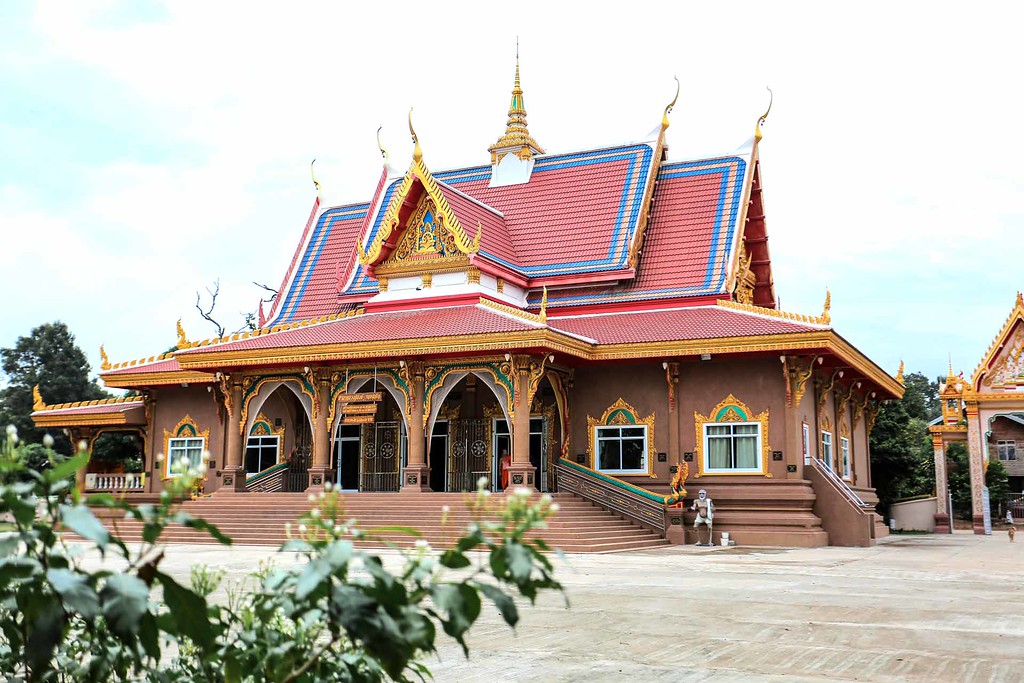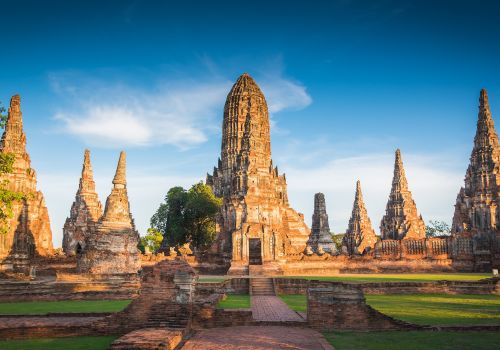Have you ever wondered about Thailand’s magnificent architectural heritage? From ancient temples to elaborate palaces, this Southeast Asian country is known for its stunning architectural designs. In this article, we’ll take a closer look at some of the most iconic landmarks in Thailand and discover the stories behind their creation. Get ready to immerse yourself in the rich cultural history of this fascinating country!
Thailand’s architectural heritage is a reflection of its deep-rooted traditions and religious beliefs. From the moment you set foot in the country, you’ll be captivated by the intricate details and grandeur of its buildings. From the iconic Temple of the Emerald Buddha in Bangkok to the ancient ruins of Ayutthaya, Thailand offers a diverse range of architectural marvels that will leave you in awe.
One of the most famous landmarks in Thailand is the Grand Palace in Bangkok. This complex of buildings served as the official residence of the Kings of Siam for over 150 years. The intricate craftsmanship showcased in every corner of the palace is a testament to the skill and dedication of the Thai people. From colorful murals to intricately carved statues, the Grand Palace is a true masterpiece of Thai architecture.
But Thailand’s architectural wonders are not limited to its capital city. The ancient city of Sukhothai, a UNESCO World Heritage Site, is home to the ruins of the first capital of the Kingdom of Siam. As you explore the temples and palaces of Sukhothai, you’ll be transported back in time to a period of great artistic and architectural achievements.
In this article, we’ll delve deeper into the history and significance of these architectural treasures, giving you a glimpse into the rich cultural heritage of Thailand. Whether you’re planning a trip to Thailand or simply interested in learning more about its history, this article will guide you through the fascinating world of Thailand’s magnificent architectural heritage. So, get ready to embark on a virtual journey through time and explore the wonders of Thai architecture.
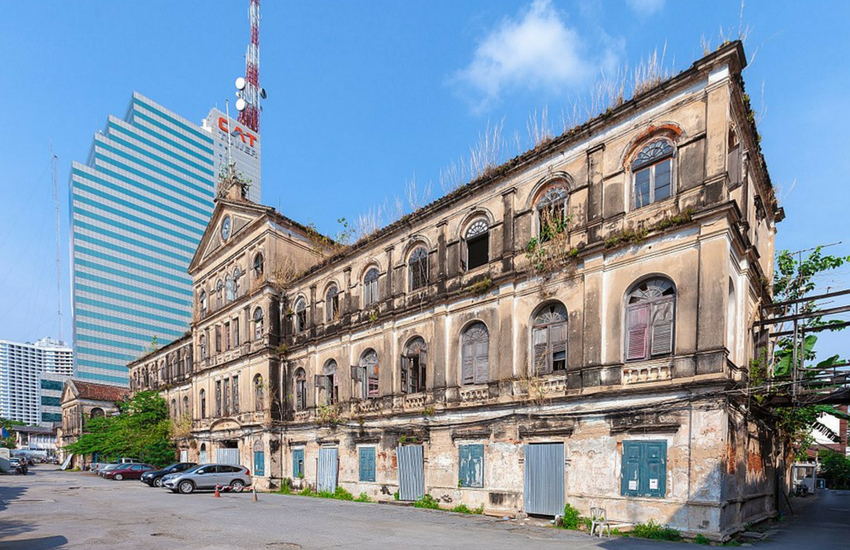
Exploring Thailand’s Magnificent Architectural Heritage
Thailand is renowned for its rich history and vibrant culture, which is beautifully reflected in its architectural heritage. From ancient temples and royal palaces to floating markets and colonial buildings, the country boasts a diverse range of architectural styles that have withstood the test of time. In this article, we will take you on a journey through Thailand’s magnificent architectural heritage, showcasing some of the most iconic structures and sites that make this country truly unique.
Khmer Influence
Thailand’s architectural heritage is deeply influenced by its neighboring country, Cambodia, and the Khmer Empire. This influence can be seen in the intricate stone carvings and grand scale of many Thai temples. One notable example is the world-famous Angkor Wat, which lies just across the border in Cambodia. Although not in Thailand, its impact on Thai architecture cannot be understated.
Sukhothai Kingdom
Moving on to Thailand itself, we first encounter the architectural wonders of the Sukhothai Kingdom. Founded in the 13th century, the kingdom is known for its distinctive and elegant architectural style. The ancient city of Sukhothai, now a UNESCO World Heritage site, features numerous temples and monuments, showcasing the exquisite craftsmanship of the era.
Ayutthaya Kingdom
Continuing our journey through time, we arrive at the Ayutthaya Kingdom, which thrived from the 14th to the 18th century. Ayutthaya, once one of the largest and most powerful cities in the world, was heavily influenced by the Khmer Empire and later developed its own unique architectural style. The temples and palaces of Ayutthaya display a fascinating blend of Khmer, Thai, and Chinese architectural elements.
Royal Palaces
In Thailand, royal palaces are not just structures of power and grandeur, but also embodiments of the nation’s rich history and cultural heritage. The two most prominent royal palaces in Thailand are the Grand Palace and Bang Pa-In Royal Palace.
The Grand Palace
Located in the heart of Bangkok, the Grand Palace is a breathtaking architectural masterpiece that has been the official residence of the Kings of Siam and Thailand for over two centuries. The complex encompasses a vast area, featuring numerous buildings, halls, and gardens that showcase a blend of Thai, European, and Chinese architectural styles. The most revered and famous site within the Grand Palace is the Temple of the Emerald Buddha, also known as Wat Phra Kaew.
Bang Pa-In Royal Palace
Situated on the banks of the Chao Phraya River, just outside Bangkok, Bang Pa-In Royal Palace is a tranquil retreat that served as the summer residence for Thai kings. The palace’s architecture reflects a fusion of Thai, Chinese, and European influences, creating a unique and visually stunning complex. The highlight of the palace is the beautifully preserved Aisawan Dhiphya-Asana Pavilion, a Thai-style pavilion set on a pond.
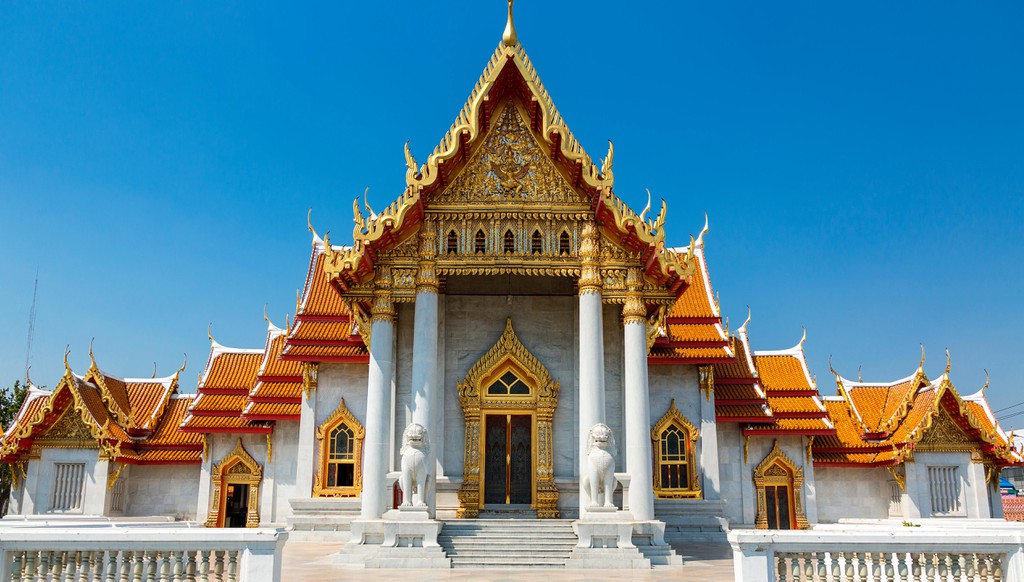
Temples and Wats
Thailand is renowned for its multitude of temples, known as Wats, which serve as both spiritual centers and architectural marvels. Here are two remarkable examples:
Wat Arun
Known as the Temple of Dawn, Wat Arun is a significant landmark in Bangkok. Its iconic central tower, or prang, stands at over 82 meters tall and is intricately adorned with porcelain and seashells, giving it a distinctive appearance. Climbing the steep stairs of the prang offers breathtaking views of the city skyline and the winding Chao Phraya River.
Wat Phra Kaew
Located within the grounds of the Grand Palace, Wat Phra Kaew is one of the most sacred Buddhist temples in Thailand. It houses the magnificent Emerald Buddha, a highly revered and meticulously carved statue of Buddha adorned with gold and precious gems. The temple’s architecture showcases intricate details and exquisite craftsmanship, making it a must-visit site for anyone exploring Thailand’s architectural heritage.
Wat Rong Khun
Moving away from the traditional, the unconventional Wat Rong Khun, also known as the White Temple, is a modern masterpiece that defies convention. Created by renowned Thai artist Chalermchai Kositpipat, this visually stunning temple features sparkling white walls and intricate murals portraying a mix of traditional Buddhist themes and contemporary imagery.
Floating Markets and Houses
Thailand’s architectural heritage also extends to its traditional houses and unique floating markets, which offer a glimpse into the country’s cultural past.
Damnoen Saduak Floating Market
One of the most famous floating markets in Thailand, Damnoen Saduak is a vibrant and bustling marketplace that showcases the traditional Thai way of life. Here, you can experience the sights, sounds, and flavors of Thailand while navigating the narrow canals in a long-tailed boat. The market is flanked by wooden houses built on stilts, showcasing the traditional Thai architectural style.
Amphawa Floating Market
Less crowded than Damnoen Saduak, the Amphawa Floating Market provides a more authentic and local experience. The market is located along the Amphawa Canal and comes alive in the late afternoon when vendors set up their boats and sell a variety of goods, including fresh seafood, local snacks, and handicrafts. The surrounding houses reflect the traditional Thai architecture, creating a nostalgic ambience.
Traditional Thai Houses
Throughout Thailand, you can still find traditional Thai houses, which are characterized by their elegant and simple design. These houses are typically made of wood and elevated on stilts to protect against flooding. The intricate carvings and use of natural materials reflect the close connection between Thai architecture and nature.
Colonial Architecture
Thailand’s architectural heritage is not confined to its ancient and traditional structures. The country also boasts a selection of colonial buildings that reflect the influence of European architecture.
Bangkok Old Customs House
Located on the banks of the Chao Phraya River, Bangkok Old Customs House is a beautiful example of colonial architecture. Built during the reign of King Rama V, the building features a combination of European and Thai design elements. Today, it serves as a museum and cultural center, showcasing Thailand’s rich maritime history.
The Oriental Hotel
The Oriental Hotel, now known as the Mandarin Oriental Bangkok, is a grand testament to the era of colonial luxury. Built in 1876, the hotel has hosted numerous famous guests, including royalty, celebrities, and writers such as Joseph Conrad and Somerset Maugham. The architectural style is a blend of Victorian, Thai, and traditional Asian influences, creating a truly opulent and elegant atmosphere.
Lanna Architecture in Chiang Mai
The northern city of Chiang Mai is renowned for its distinctive Lanna architecture, which encompasses a blend of Thai, Burmese, and Chinese influences.
Wat Phra Singh
One of Chiang Mai’s most significant temples, Wat Phra Singh is a shining example of Lanna architecture. The temple’s intricate wood carvings, gilded roofs, and picturesque gardens transport visitors to a bygone era of elegance and serenity.
Wat Chedi Luang
Another notable Lanna-style temple is Wat Chedi Luang, famous for its towering pagoda. Built in the 14th century, the pagoda was once the tallest structure in Chiang Mai and served as the focal point of the Lanna Kingdom’s religious life.
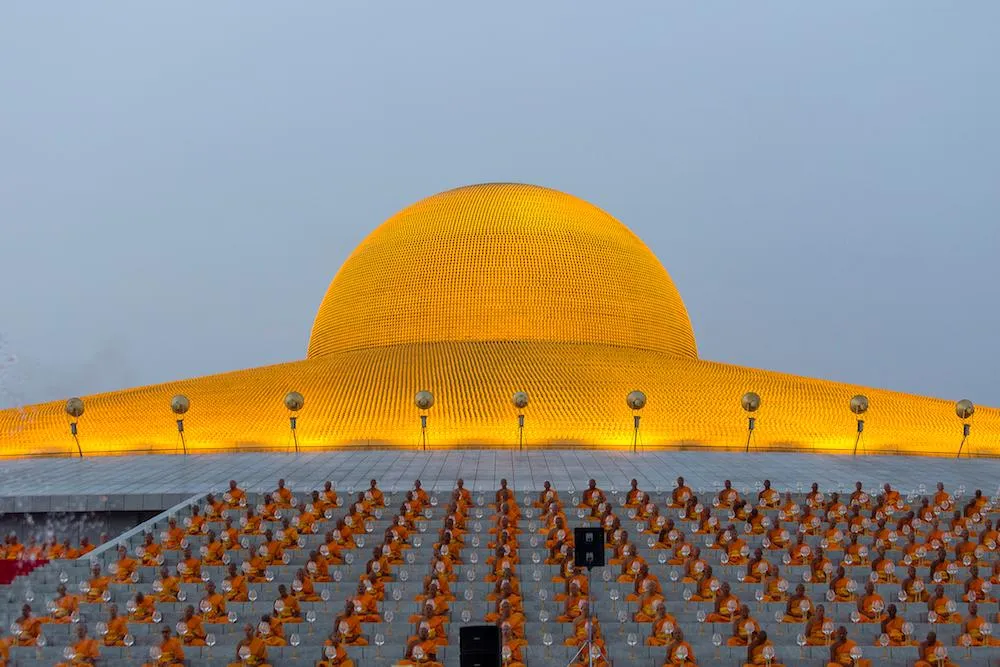
Ancient Cities
Thailand is also home to several ancient cities that offer a glimpse into the country’s glorious past and architectural wonders.
Phimai Historical Park
Located in the northeastern province of Nakhon Ratchasima, Phimai Historical Park is an awe-inspiring testament to the glory of the Khmer Empire. The park is home to the magnificent Phimai Temple, built in the 11th century, which features intricate carvings and imposing towers.
Sukhothai Historical Park
Returning to the Sukhothai Kingdom, the Sukhothai Historical Park preserves the ruins of the ancient capital city. The park is dotted with stunning temples, statues, and crumbling walls that transport visitors back in time and offer a glimpse into the grandeur of the Sukhothai era.
Modern Thai Architecture
Thailand’s architectural heritage isn’t limited to the past. The country also showcases modern architectural marvels that blend innovation and tradition.
Baiyoke Tower II
Standing as the tallest building in Thailand, the Baiyoke Tower II dominates the Bangkok skyline. The tower’s sleek design and panoramic views make it a popular attraction for both locals and tourists, offering a modern perspective on Thailand’s architecture.
Siam Paragon
As one of the largest malls in Southeast Asia, Siam Paragon in Bangkok is a striking example of modern Thai architecture. The mall’s sleek design, glass façade, and iconic central atrium create a visually stunning environment that perfectly blends functionality and aesthetics.
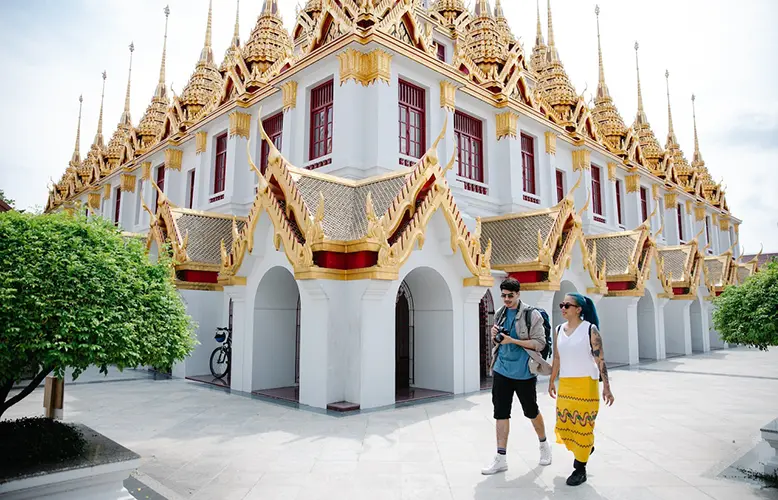
Traditional Thai Architecture
Despite the rise of modernity, traditional Thai architecture continues to thrive and inspire, preserving the nation’s cultural identity.
Thai Houses
Throughout rural and urban areas of Thailand, traditional Thai houses can still be found. These houses are characterized by their use of natural materials, steeply pitched roofs, and intricate wood carvings. They reflect the harmony between humans and nature, striking a perfect balance between functionality and beauty.
Phra That Phanom
Phra That Phanom is a revered Buddhist temple located in northeastern Thailand. Its central chedi is adorned with intricate gold and white decorations, creating a mesmerizing display of traditional Thai craftsmanship.
Conclusion
Exploring Thailand’s magnificent architectural heritage is a journey through time, from the ancient Khmer-influenced structures to the grand royal palaces, enchanting temples, and charming traditional houses. The country’s rich history and cultural diversity are beautifully captured in its architectural marvels. Whether you wander through the grandeur of the Grand Palace, marvel at the intricate carvings of Wat Arun, or experience the vibrant atmosphere of a floating market, Thailand’s architectural heritage will leave you in awe and ignite a deep appreciation for the nation’s artistic and cultural legacy. So, immerse yourself in the enchanting world of Thai architecture and embark on a journey that will undoubtedly leave a lasting impression.
